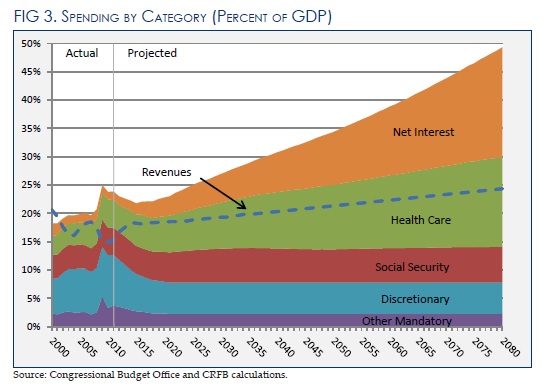The Updated CRFB Long-Term Realistic Baseline
Update: CRFB's newest policy paper, What We Hope to See from the Super Committee, shows CRFB Realistic projections for spending by category and revenues over the long-term. Check out the graph (posted below) and the rest of our recommendations!
In light of the Budget Control Act (BCA) that passed one month ago and updated budget and economic projections from CBO, CRFB has updated its 75-year Realistic Baseline.
As a refresher, the Realistic Baseline incorporates policies that seem likely to happen, not what we would like see happen. It assumes that all the 2001/2003 tax cuts are extended, the AMT is patched, physician payments are frozen instead of cut by 30 percent (the doc fix), the wars are drawn down as scheduled, discretionary spending stays within the BCA caps, the Super Committee does not produce any savings and the required trigger is not implemented.
In the long-term (beyond the ten-year window), we assume the cost containment mechanisms contained in the Affordable Care Act are only partially successful (or only partially remain in place), discretionary and other mandatory spending stay constant as a percent of GDP, and revenue grows as a percent of GDP to account for growth in real wages slowly pushing people into higher tax brackets.
Given the fact that the BCA did not do enough to stabilize our debt in the medium-term, it should be no surprise that it did not do nearly enough to stem the exploding tide of red ink that will come over the longer term (at least according to our baseline). Under the new baseline, debt climbs higher and higher, going from 81 percent of GDP in 2021 to 124 percent in 2035, 194 percent in 2050, and 399 percent in 2080. As you can see, the BCA made an improvement, but not much of one, over the long-term.
Also, as expected, entitlement spending will explode over the long-term. Total Social Security and Federal health care spending will climb from 9.7 percent of GDP in 2012 to 17.3 percent in 2050, and it will continue to go higher as health care spending grows as a percent of GDP.
We have a lot of work to do. It's up to lawmakers to put in place a comprehensive budget plan soon that makes our Realistic Baseline look much better.
